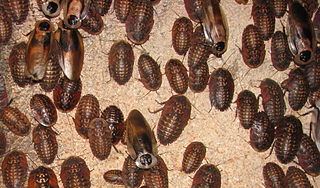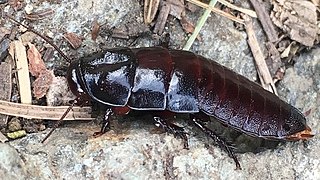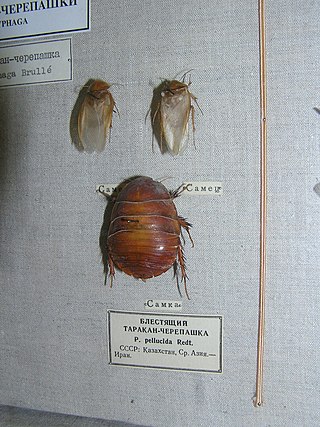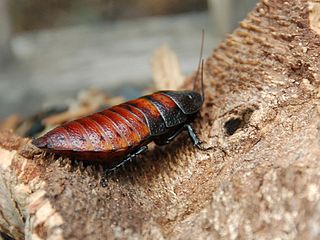
Bookworm is a general name for any insect that is said to bore through books.

Dictyoptera is an insect superorder that includes two extant orders of polyneopterous insects: the order Blattodea and the order Mantodea (mantises). While all modern Dictyoptera have short ovipositors, the oldest fossils of Dictyoptera have long ovipositors, much like members of the Orthoptera.

Giant cockroaches, or blaberids are the second-largest cockroach family by number of species.

An ootheca is a type of egg mass made by any member of a variety of species including mollusks, mantises, and cockroaches.

Blattidae is a cockroach family in the order Blattodea containing several of the most common household cockroaches. Notable species include:

The American cockroach is the largest species of common cockroach, and often considered a pest. In certain regions of the U.S. it is colloquially known as the waterbug, though it is not a true waterbug since it is not aquatic. It is also known as the ship cockroach, kakerlac, and Bombay canary. It is often misidentified as a palmetto bug.

The Florida woods cockroach or palmetto bug is a large cockroach species which typically grows to a length of 30–40 mm (1.2–1.6 in). When alarmed, adults can eject an extremely foul-smelling directional spray up to 1 m, which inspired several of its other common names: Florida skunk roach, Florida stinkroach, skunk cockroach, skunk roach, stinking cockroach, and stinkroach. Two other naming variations include Florida cockroach and Florida woods roach.

The German cockroach, colloquially known as the croton bug, is a species of small cockroach, typically about 1.1 to 1.6 cm long. In color it varies from tan to almost black, and it has two dark, roughly parallel, streaks on the pronotum running anteroposteriorly from behind the head to the base of the wings. Although B. germanica has wings, it can barely fly, although it may glide when disturbed. Of the few species of cockroach that are domestic pests, it probably is the most widely troublesome example. It is very closely related to the Asian cockroach, and to the casual observer, the two appear nearly identical and may be mistaken for each other. However, the Asian cockroach is attracted to light and can fly like a moth, while the German cockroach cannot.

Ectobiidae is a family of the order Blattodea (cockroaches). This family contains many of the smaller common household pest cockroaches, among others. They are sometimes called wood cockroaches. A few notable species include:

Cryptocercus is a genus of Dictyoptera and the sole member of its own family Cryptocercidae. Species are known as wood roaches or brown-hooded cockroaches. These roaches are subsocial, their young requiring considerable parental interaction. They also share wood-digesting gut bacteria types with wood-eating termites, and are therefore seen as evidence of a close genetic relationship, that termites are essentially evolved from social cockroaches.

Corydiidae, previously known as Polyphagidae, is a family of the order Blattodea (cockroaches). Many are known as sand cockroaches. The family is divided into five subfamilies, comprising some 40 genera. One prominent species is the desert cockroach, Arenivaga investigata.

The Madagascar hissing cockroach, also known as the hissing cockroach or simply hisser, is one of the largest species of cockroach, reaching 5 to 7.5 centimetres at maturity. They are native to the island of Madagascar, which is off the African mainland, where they are commonly found in rotting logs. It is one of some 20 known species of large hissing roaches from Madagascar, many of which are kept as pets, and often confused with one another by pet dealers; in particular, G. portentosa is commonly confused with G. oblongonota and G. picea.

Blattodea is an order of insects that contains cockroaches and termites. Formerly, termites were considered a separate order, Isoptera, but genetic and molecular evidence suggests they evolved from within the cockroach lineage, cladistically making them cockroaches as well. The Blattodea and the mantis are now all considered part of the superorder Dictyoptera. Blattodea includes approximately 4,400 species of cockroach in almost 500 genera, and about 3,000 species of termite in around 300 genera.

Cockroaches are a paraphyletic group of insects belonging to Blattodea, containing all members of the group except termites. About 30 cockroach species out of 4,600 are associated with human habitats. Some species are well-known as pests.

The giant burrowing cockroach is also known as the rhinoceros cockroach, and Queensland giant cockroach. These cockroaches are native to Australia and mostly found in tropical and subtropical parts of Queensland. They are the world's heaviest species of cockroach and can weigh up to 30-35 grams and measure up to 7.5-8 cm (3.1 in) in length. It is a member of the family Blaberidae, which contains hundreds of species. It is part of the blaberid subfamily Geoscapheinae. It is prominent in the wild and can also be sold and kept as a pet.

The emerald cockroach wasp or jewel wasp is a solitary wasp of the family Ampulicidae. It is known for its unusual reproductive behavior, which involves stinging a cockroach and using it as a host for its larvae. It thus belongs to the entomophagous parasites.

The Ampulicidae, or cockroach wasps, are a small, primarily tropical family of sphecoid wasps, all of which use various cockroaches as prey for their larvae. They tend to have elongated jaws, pronounced neck-like constrictions behind the head, strongly petiolate abdomens, and deep grooves on the thorax. Many are quite ant-like in appearance, though some are brilliant metallic blue, green, and hot pink.

The Turkestan cockroach, also known as the rusty red cockroach, red runner cockroach or simply rusty red, red runner, or lat, is a primarily outdoor-dwelling cockroach native to an area from northern Africa to Central Asia. Adults measure around 3 cm (1.2 in) in length. Adult males are a brownish orange or red, are slender, and have long, yellowish wings which allow it to attract females and to glide. Adult females are dark brown to black, with cream-colored markings on the shield and a cream-colored stripe edging its wings; they are broader than males, and have short vestigial wings. Nymphs are brown in front, black on the rear, and are wingless.
Blabericolidae is a family of parasitic alveolates in the phylum Apicomplexia.

















